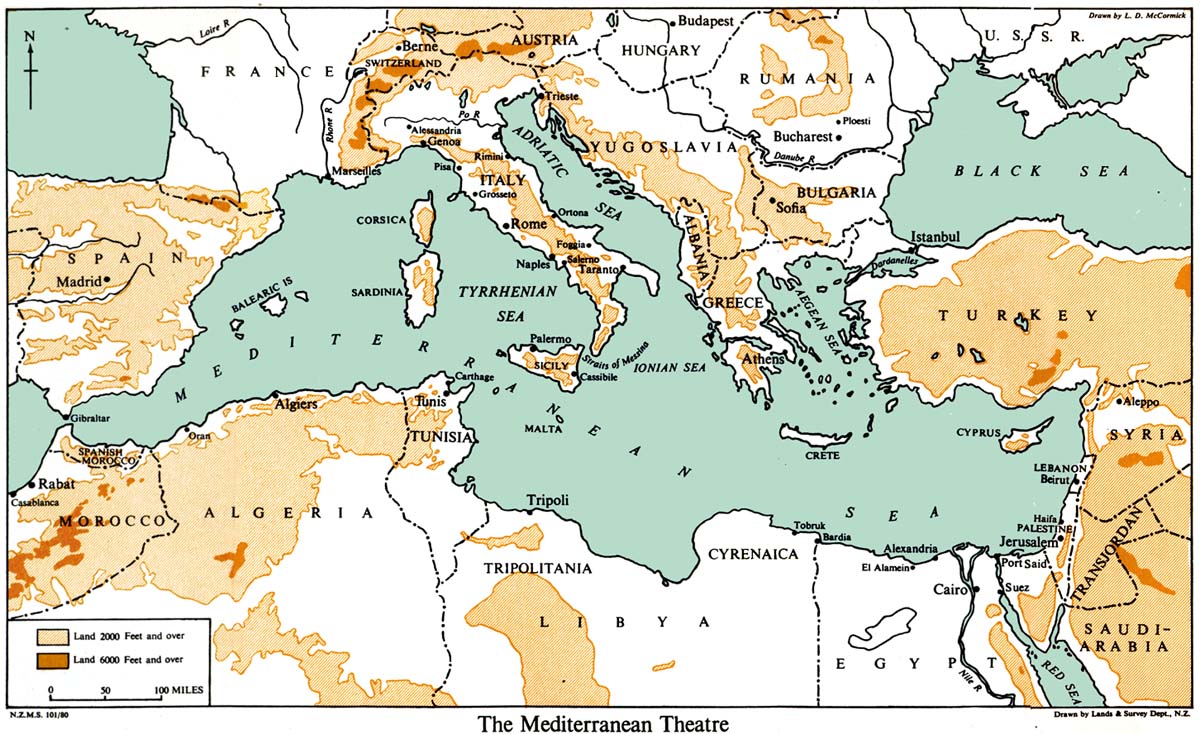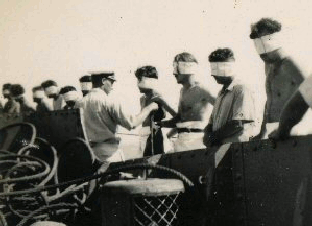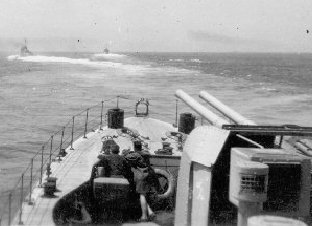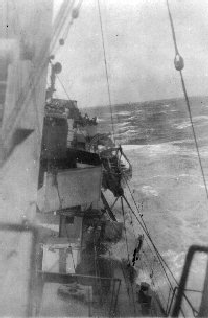THE MEDITERRANEAN
Leaving the UK with Convoy WS-18, for the next three years Tetcott and her crew were to become involved in almost every major action in the Mediterranean theatre - Sicily, Anzio, Salerno, and the Dodecanese. She was part of the Vigorous and Pedestal convoys in 1942, and operations Retribution and Husky in 1943.
To read an extract from Lt Cmdr Rycroft's Official Report on the actions of HMS Tetcott during Operation Husky, click HERE.

On 5th August 1942, Lt Cdr H Rycroft was able to report the sinking of the German submarine U-372 at 13:37 the previous day. The Tribal Class destroyers HMS Sikh and Zulu had been engaged on an A/S sweep to cover the passage of a convoy. At 02:45 Sikh  made contact with a suspected U-boat and dropped her first depth charges. There followed a game of cat-and-mouse between the enemy submarine and the two destroyers.
made contact with a suspected U-boat and dropped her first depth charges. There followed a game of cat-and-mouse between the enemy submarine and the two destroyers.
Sighting the activity from Haifa at just after 12:00, Tetcott and her sister ship HMS Croome raised steam immediately and began their search for the intruder. Taking over from the two Tribal Class destroyers – who had both run out of depth charges - Tetcott dropped a large pattern at 12:53, followed at 13:10 by another pattern dropped by Croome. Tetcott’s second pattern came at 13:20, when the U-boat was between 30 and 40 yards off her port quarter. This last salvo appeared to cause sufficient damage to force the U-boat to surface. Starting her diesel engines immediately, the U-boat made a further attempt to evade the hunters. When some 800 yards from Tetcott, both destroyers brought every available gun around onto the vessel, peppering her with shells.
Resigned to their fate, a white flag was waved from the conning tower, and the crew barely had time to jump into the sea before the submarine sank by the stern, her bow sticking up into the air, before finally disappearing beneath the waves.
Working fast, Tetcott immediately dropped the scramble nets, hauling man after man onto her decks. Herded forward to the bow, the exhausted Germans watched as their vessel slipped back beneath the waters and disappeared. The entire crew of 48 managed to escape the stricken submarine. After cursory interrogation by Rycroft, the ships returned to Haifa where the 48 blindfolded prisoners - including the Captain, Heinz-Joachim Neumann - were led from the decks of HMS Tetcott, across Sikh and away to spend the remainder of the war in a PoW Camp. Click HERE to see the London Gazette extract regarding awards made in relation to the sinking of U-372.
By September, the last operational U-boats in the Mediterranean had been eliminated, with the result that it was soon possible to substitute single-ship sailings instead of escorted convoys, though Tetcott was to spend the entire month plying the route between Port Said and Alexandria.
November saw a return to convoy escort duties, with visits to Alexandria, Port Said, Algiers and Oran. Everything needed by the Allies in the entire Mediterranean theatre still needed to be brought in by sea and, with the exception of what was moved locally by landing ships and craft, and in the all-too-few small coasters, everything came in big ships.
After much organisation and weeks of loading up stores for the starving population, the convoy for the  replenishment of Greece sailed from Alexandria early in November. At the beginning of December, Tetcott left Taranto with yet another supply convoy arriving at the Greek port of Piraeus, where she anchored off the rocky promontory, remaining there until 13 December. The ship returned to Alexandria and, after a short trip to Port Said to pick up another supply convoy, she returned once again to Piraeus, being at anchor there for Christmas Day.
replenishment of Greece sailed from Alexandria early in November. At the beginning of December, Tetcott left Taranto with yet another supply convoy arriving at the Greek port of Piraeus, where she anchored off the rocky promontory, remaining there until 13 December. The ship returned to Alexandria and, after a short trip to Port Said to pick up another supply convoy, she returned once again to Piraeus, being at anchor there for Christmas Day.
January 1945, the start of another new year. The war in the Mediterranean began winding down and the Allies started closing bases and transferring ships and resources to the Pacific theatre. From a total of 39 Hunts on station in the Mediterranean the previous year, only 17 now remained, and by the beginning of May this had dropped to just 12. However, numerous warships and landing craft, including Tetcott (which only made one trip to Malta and a return trip to Alexandria during the month) were to remain in the Mediterranean for a variety of tasks.
By February 1945 the losses inflicted upon the enemy's shipping had been so severe that suitable targets for the British and American light coastal craft were not easy to find. There was less need for the large escorted convoys, though the threat, however small of aerial or underwater attack, was to  ensure that a number of destroyers, including Tetcott, were to remain in the Mediterranean until the very last days of the war.
ensure that a number of destroyers, including Tetcott, were to remain in the Mediterranean until the very last days of the war.
Tetcott worked out of Naples for all of February and into March, before leaving with another convoy laden with stores and supplies on 21 March, bound for the port of Leghorn. At Leghorn, Tetcott, in the company of HMS Marne, escorted an American tank landing craft from the port to the southern French port of Marseilles. Tetcott, Marne and the landing craft headed north to Genoa where the destroyers shelled the enemy, before turning and sailing back to Leghorn. Tetcott was to continue on these three-way-runs for the last months of the war.
Tetcott's company were to experience the jubilation of a newly liberated Europe with the people of Malta, where they arrived on 11 May 1945. The Grand Harbour appeared the same as on Tetcott's earlier visits, a graveyard for scores of ships, whilst ashore every building appeared shattered, crumbling into the ground.
More good news was received at the end of May, with orders for Tetcott to return to the UK to give leave and undertake repairs, with the prospect of further service in the Pacific theatre. Tetcott arrived at Portsmouth on 21 May.
With orders to proceed back to Gibraltar for refit prior to being posted to the Pacific, the new Acting Lieutenant Commander John Alexander Jeffreys Dennis took the ship out of Portsmouth at the end of June, arriving at Gibraltar, where she was taken in hand on 5 July.